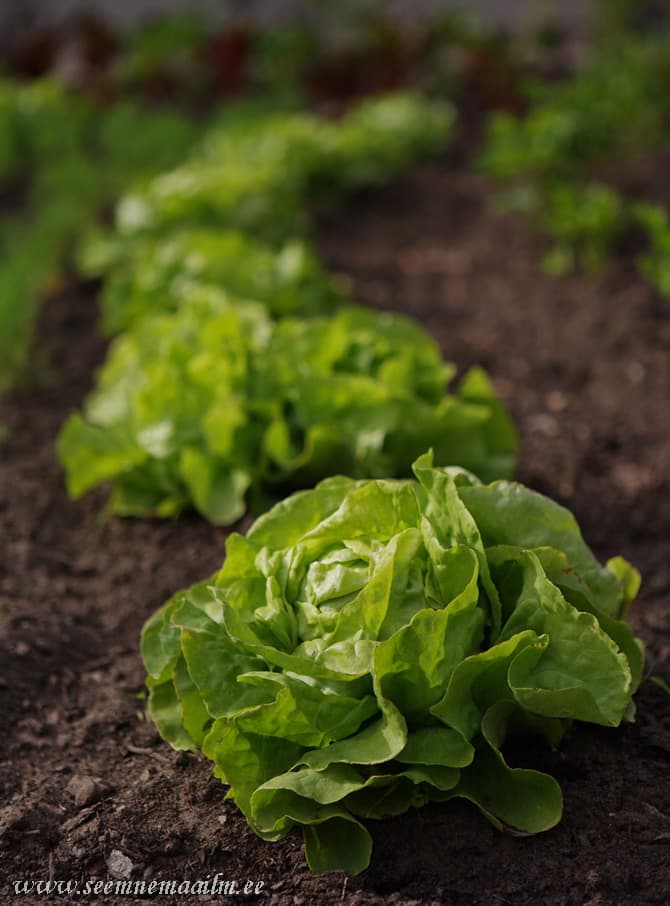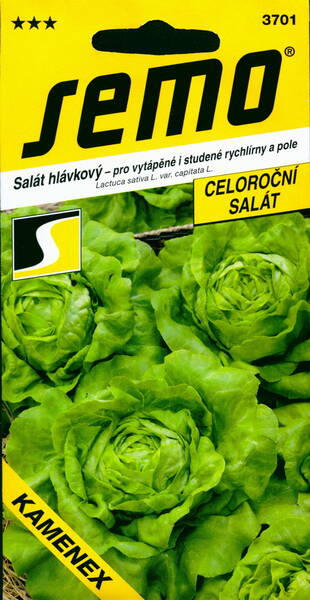For year-round cultivation: four seasons!
Cultivated in plastic greenhouses and in open field. Seedlings grow within 2-3 weeks. This lettuce is resistant to frost, therefore can be sown outdoors after the coltsfoot starts blooming.
1,0 g = 800-1200 seeds.
Agricultural technology.
The best predecessors for lettuce are cabbage, potatoes, under which organic fertilizers were applied. In autumn, plowing or digging is carried out with the introduction of humus. Acidic soils require liming. Mineral fertilizers are applied in spring.
Seeds are sown in open ground in early April, in wide rows with row spacing of 60-70 cm. Sowing depth is 1.5-2 cm. Rolling is carried out before and after sowing.
When dense seedlings appear, thinning is performed twice: in the phase of one true leaf at a distance of 5-7 cm and 1.5 months after sowing, leaving a distance of 15-20 cm between plants. After thinning, fertilizing is carried out with a solution of a special complex fertilizer.
Care consists in loosening row spacing and watering. Watering is carried out along the furrows, trying to avoid getting water on the leaves of plants.
Lettuce harvesting is carried out by cutting off the rosette of leaves at the very surface of the soil.

* How to grow a truly large lettuce.
Lettuce is one of the most practical crops in the garden. Planting just one salad in your country house will already noticeably decorate the table, since its fresh greens are appropriate for breakfast, lunch, and dinner!
Lettuce is so in demand that it is often sown several times in May and June to get young plants in stages.
Planting and care: the fastest and most reliable way to get large heads of lettuce. We pour the purchased bag with seeds of the variety we like, as evenly as possible onto a piece of clean land (with an area of more than 0.5 sq. m), we close it with a chopper into the ground, water it and cover the sowing with a wooden box to prevent the soil from drying out. After a week, we check: as soon as the first cotyledons appear, we remove the box and allow the seedlings to grow to the state of 2-3 true leaves.
And now, when the size of each plant is clearly visible, the most crucial stage comes: seating the largest bushes on a spacious plot prepared elsewhere to create heads of cabbage. You carefully dig out a few dozen of the largest plants, transfer them to a new place and plant one at a time strictly according to the 20x20 cm pattern.
Watering and mulching - as when planting any seedlings. Then you just have to watch how heads of cabbage are obtained from tiny bushes. Well, the rest - in the same place "small" let it grow like that, you use it for food first, while the bushes take root and grow on the main plot.
Land for lettuce is prepared in the same way as for other vegetable crops that require the elimination of soil acidity pH. Early impregnation with a deoxidizer, fertilizer with liquid nitrogen humus infusion. We exclude the top dressing of growing lettuce bushes in order to avoid the accumulation of nitrates in the leaves. Only frequent watering.
This example, by the way, can also be used to grow other green crops in the beds in the family garden.
With this pattern, you can grow almost any large green: from lettuce and basil to leek and sage.












